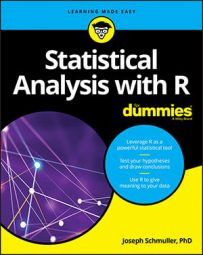scale(). Supply a vector of scores, and scale() returns a vector of z-scores along with, helpfully, the mean and the standard deviation.To show scale() in action, isolate a subset of the Cars93 data frame. (It's in the MASS package. On the Packages tab, check the box next to MASS if it's unchecked.)
Specifically, create a vector of the horsepowers of 8-cylinder cars from the USA:
> Horsepower.USA.Eight <- Cars93$Horsepower[Origin == "USA" & Cylinders == 8]
> Horsepower.USA.Eight
[1] 200 295 170 300 190 210
And now for the z-scores:
> scale(Horsepower.USA.Eight)
[,1]
[1,] -0.4925263
[2,] 1.2089283
[3,] -1.0298278
[4,] 1.2984785
[5,] -0.6716268
[6,] -0.3134259
attr(,"scaled:center")
[1] 227.5
attr(,"scaled:scale")
[1] 55.83458
That last value is s, not Σ. If you have to base your z-scores on Σ, divide each element in the vector by the square root of (N-1)/N:
> N <- length(Horsepower.USA.Eight)
> scale(Horsepower.USA.Eight)/sqrt((N-1)/N)
[,1]
[1,] -0.5395356
[2,] 1.3243146
[3,] -1.1281198
[4,] 1.4224120
[5,] -0.7357303
[6,] -0.3433408
attr(,"scaled:center")
[1] 227.5
attr(,"scaled:scale")
[1] 55.83458
Notice that scale() still returns s.

